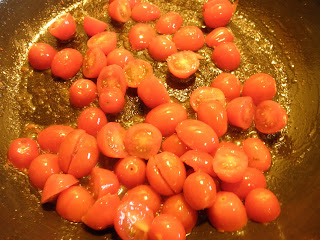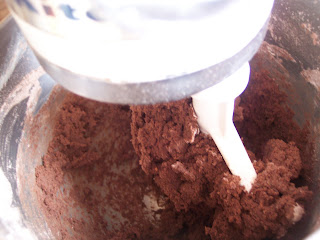Just the name sounds awesome. Maybe because "bucatini" itself is fun to say. And the recipe (from a sample issue of "Cuisine at home" magazine) brings together the main ingredients of a BLT (sort of) to make a fairly light pasta sauce. Who could resist?
OK, well technically, "BLT" is a misnomer here. The recipe I was working off used spinach, probably because it was going to be slightly cooked. I, however, am not a big fan of cooked spinach (except in spanakopita) and substituted basil for the substituted spinach. So technically, it was BBT Bucatini.
It still had the bacon -- turkey bacon at our house, but bacon nonetheless. It had the tomatoes, in the form of bite-sized grape tomatoes. It even had the toasted bread, namely garlic bread crumbs sprinkled on top. It did not have mayonnaise, but that's a good thing in my book. Especially in a pasta sauce.
I started by making the bread crumbs from a half of a French batard. I cut them into cubes, then put them into the food processor with some minced garlic. Then, I toasted them in a skillet with a little olive oil. Mmm.
Next, I cooked some diced turkey bacon in a separate skillet. The idea was to cook until crispy, but turkey bacon lacks the fat to get really crispy. I cooked it until it was close enough, then set the bacon aside.
At this point, I was supposed to leave about 1 Tablespoon of bacon pan drippings in the skillet, but as mentioned, turkey bacon lacks the fat. So I added a little canola oil and when it was heated, I tossed in the tomatoes and a little sugar for caramelizing.
 I meant to add some sliced scallions when the tomatoes started to brown, but forgot that I had used up the scallions earlier in the week. Oops. After the tomatoes had been cooking about 7 minutes, I poured in some white wine to deglaze the pan. Meanwhile, I had started the pasta cooking in a pot on the back burner.
I meant to add some sliced scallions when the tomatoes started to brown, but forgot that I had used up the scallions earlier in the week. Oops. After the tomatoes had been cooking about 7 minutes, I poured in some white wine to deglaze the pan. Meanwhile, I had started the pasta cooking in a pot on the back burner.When the wine was nearly evaporated, I added some chicken stock, red wine vinegar and the teeniest shake of red pepper flakes. Maybe 10 flakes? Red pepper flakes are tough -- Will and I would have been fine with 1/2 teaspoon, but experience has taught us to go easy on the red pepper for the kids. We can always add more to our own plates.
I let the sauce bubble away for 5 or 6 minutes while the pasta finished. I stirred the reserved bacon pieces and some dried marjoram into the sauce, then took it off the heat while I added about 2 cups of basil leaves. I tossed the sauce with the drained pasta, and served it with bread crumbs sprinkled on top.
 THE VERDICT: Mmm. The sauce was great to begin with, but the crunch of the bread crumbs made the dish. Of course, I committed my usual error of increasing the amount of pasta without proportionally increasing the amount of sauce, so it was perhaps a bit on the thin side and it could have used more bacon. Pancetta, if it's in the budget, would also work very well here.
THE VERDICT: Mmm. The sauce was great to begin with, but the crunch of the bread crumbs made the dish. Of course, I committed my usual error of increasing the amount of pasta without proportionally increasing the amount of sauce, so it was perhaps a bit on the thin side and it could have used more bacon. Pancetta, if it's in the budget, would also work very well here. As for the family verdict... Will: "Saucy bucatini is delectable." Alex: "This is so good, they should serve it for first-grade lunch." Keith: "It's good." A keeper.
BLT Bucatini (adapted from "Cuisine at home" magazine)
serves 4
2 c. cubed French bread
2 garlic cloves
2 tsp. olive oil
6 slices (or more) turkey bacon, diced
1 Tbsp. canola oil
1 pint grape or cherry tomatoes, halved
1 tsp. sugar
1/2 c. dry white wine
1 c. chicken broth/stock
2 tsp. red wine vinegar
1/2 tsp. red pepper flakes (optional)
pinch dried marjoram or thyme
2 c. basil leaves
bucatini or thin spaghetti for four
1. Mince garlic in a food processor. Add the bread cubes and pulse until coarse. Heat olive oil in a skillet. Pour in garlic bread crumbs and cook, stirring frequently, until golden brown. Pour onto a plate and set aside.
2. In a large skillet, cook diced bacon to desired taste. Set aside on paper towel-lined plate. Meanwhile, start heating water in pasta pot.
3. Leave 1 Tbsp. pan drippings, if any, in skillet. Add canola oil to bring it to 1 Tbsp. if needed. Add tomatoes and sugar, stirring frequently, until tomatoes begin to brown, about 5 minutes. Cook about two minutes longer, then add white wine to deglaze pan. Meanwhile, add pasta to boiling water in pasta pot.
4. Cook tomatoes until wine nearly evaporates. Add chicken broth, vinegar and red pepper (optional) to tomatoes and bring to a boil. Cook until liquid is reduced by one-third, about 5 minutes.
5. Drain pasta, and return to pot.
6. Stir bacon and marjoram into skillet with tomatoes and sauce. Remove from heat and add basil leaves. Quickly toss with spaghetti. Serve in bowls with bread crumbs sprinkled on top.




















































